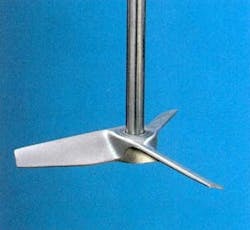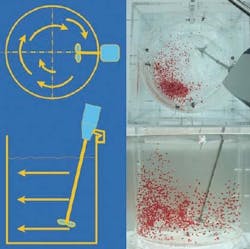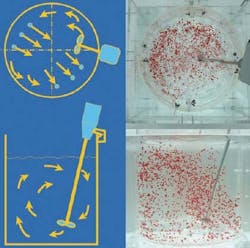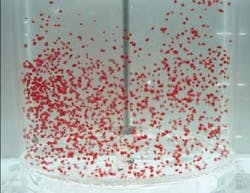Portable mixers are used throughout the chemical industry and many other manufacturing industries to blend liquids and suspend solids. Success depends on a basic understanding of agitation. In particular, the user should know how a mixers orientation affects fluid flow.
Flow patterns control how liquids are blended and solids are suspended or incorporated into liquids. Other mixing characteristics can be important, such as reducing the air entrainment. Ultimately, the product must not only meet the customer's requirements but also the processor's need for economical production. Understanding the fundamentals of fluid agitation can help meet both objectives.
Figure 1. Hydrofoil impellers like the A-310 above provide the most flow for the power.
The typical portable mixer has a motor that is 2 hp or less. Its usually clamp-mounted on the side or cup-mounted near the side of an open tank. Generally, the tank doesnt have baffles. Low cost, and readily available, these mixers are useful for a variety of applications.
Even though theyve been around for years, portable mixers are often not used to their full potential. Understanding how a portable mixer works doesnt require an engineering degree. However, you do need to know some basics of mixing and flow patterns. Typical applications include blending liquids and mixing solids and liquids to make solutions or dispersions. The goal of blending is to create or maintain uniformity in miscible or nonmiscible liquids. Uniformity is a measure of the normalized decrease in concentration differences against a blend time.
The addition of powders is usually more complicated than simply blending liquids. Some solids dissolve to form solutions, while others form dispersions or suspensions. Solutions form best when the added particles or agglomerates can be suspended off the bottom of the tank. What works best during one phase of the mixing process may not work well later on. Dissolving powders may change the mixing properties of liquids, e.g., increase the viscosity. Poorly dispersed powders can form lumps or large agglomerates. Rapid initial mixing often minimizes the formation of lumps, provided the solid is added in a controlled way, but also increases entrainment of air. Viscous fluids create other mixing problems, for which portable mixers have limited capabilities.
While portable mixers can do many different tasks, selecting the best mixing characteristics can make the difference between success and failure of a batch or product.
A common misunderstanding about mixing is that vigorous motion on the surface isnt necessarily a sign of good mixing. Often the first sign of poor mixing is a strong vortex. In other cases, the surface motion may be helpful for certain process steps, such as powder addition. Learning what happens below the liquid surface and when certain mixing characteristics are required will go a long way to understanding how to make the best use a portable mixer.
The portable mixer
Portable mixer sizes typically start at 1/4 hp and go to 2 hp. Some larger mixers have 3-hp motors, but those usually require a rigid mount, different from the portable-style adjustable mount. Simply knowing the motor horsepower isnt enough to gauge the mixing capabilities of a mixer; in the past, rules of thumb often referred to horsepower per 1,000 gallons.
Portable mixers fall in two general categories direct-drive (high speed) and gear-drive (low speed) mixers. The direct-drive mixers have a shaft and impeller that turn at the motor speed, usually 1,750 rpm. The impeller, also known as a prop, hydrofoil, or turbine, on direct-drive mixers is typically from three (3) to seven (7) in. in diameter. Gear-drive mixers often run at 350 rpm, although other speeds are available. Gear-drive mixers will have impellers from eight to 17 in. in diameter. A variable speed drive may offer a range of speeds.
It should be no surprise that a small impeller operating at a high speed or a large impeller operating at a low speed produce the same mixing intensity.
P = 6.566 X 10-14(NpN3D5ρ)
P: Agitator power, hp
Np: Impeller power number, vendor
N: Shaft speed, rpm
D: Impeller diameter, inches
ρ: Fluid specific gravity
The difference is in how much horsepower is required. A 1/4-hp gear-drive mixer will usually provide more agitation intensity than a 1-hp direct-drive mixer. The reason is that agitation intensity is more closely related to how much torque is applied to the fluid than how much horsepower. Torque is proportional to power divided by speed, so the same power at a lower speed can create more intense agitation.
Most portables use either a marine-type propeller or a vendor-specific hydrofoil impeller. The hydrofoil impeller is an improvement over the marine propeller because it weighs less and can provide more flow at a given power draw. Both types of impellers provide strong axial flow, a characteristic that plays an important role in deciding how best to position the mixer in the tank to get maximum advantage for your application. Other types of impellers can be used for mixing applications, including pitched-blade turbines, straight-blade turbines, disperser disks, or other special application designs.
Typically, small impellers operating at high speed are more cost-effective for blending small batches of liquid or creating dispersions and emulsions. Large impellers operating at low speeds are better for bulk mixing or in high viscosity fluids.
Positioning the mixer
Proper positioning of a portable mixer is an effective in-plant way for process improvement. A good portable mixer mount should allow the mixer to be positioned with respect to both the vertical axis and horizontal orientation. A well-positioned portable mixer starts with the shaft angled between 10° and 15° from vertical. This position should place the impeller on the same side of the center of the tank as the mixer mounting. The objective is to have the axial flow from the impeller sweep down and across the bottom of the tank. In such a configuration a vortex may form.
Now, the difficult part of understanding mixing: a strong vortex isnt necessarily a good thing. If the shaft of the mixer, when viewed from above, points straight across the tank, strong rotational flow will occur. With this installation, a vortex will form around the rotating shaft. Mixers typically rotate clockwise when looking from behind the motor, so that rotation is transferred to the fluid. The result is clockwise rotational flow in the tank. What is wrong with rotational flow? If the objective of a process step is to add a powdered ingredient to the liquid, strong surface motion with a vortex may help. If the object is to achieve uniform mixing from the top to the bottom of the tank, rotational flow isnt the best solution.
Figure 2. Particles are poorly distributed on one side of the tank with the shaft aimed straight across the tank.
Figure 2 shows the drawbacks of rotational motion. While it looks as if the surface of the fluid is moving well, particles in the top-view photograph swirl around the outside of the tank. The side-view photo shows that most of the settling particles are on one side of the tank. The side-view photo also shows a small vortex on the surface above the impeller location. Unfortunately, any still picture of agitation shows only a part of the story, because agitation is an active process. These still photos dont adequately show the rotational swirl and random patterns of the actual mixing.
Greater rotational speed or a larger impeller will draw a deeper vortex from the liquid surface. When the vortex reaches the impeller, air will be drawn into the fluid. The entrained air may not only cause foaming or bubbles in the product, but the air disrupts the liquid flow through the impeller and reduces the effectiveness of the mixing. A strong vortex reaching the impeller is usually a sign of poor mixing.
Because the impeller creates axial flow, aiming the mixer shaft far to the right will create a rotational flow in the opposite direction of the inherent swirl (Figure 3).
Figure 3. Induced motion reverses the direction of rotation compared with inherent motion.
The top-view photo shows that particles are driven from the side where the impeller is located primarily because the dished bottom redirects the axial discharge flow. The side view shows that the settling particles are driven toward the surface, but only on the side away from the mixer. While creating some vertical motion with this location, the uniformity of mixing is unsatisfactory.
Achieving a compromise between clockwise and counterclockwise motion seems like a good objective for both side-to-side and top-to-bottom motion. Angling the shaft to the right just enough to counter rotational flow produces an effective bulk mixing pattern (Figure 4).
Figure 4. Moderate orientation towards the right, improves vertical mixing.
In the graphic pattern, the circles with dots in them represent the heads of arrows for flow coming toward the surface with arrows going away from them representing the flow moving across the surface. The arrows pointing toward circles with crosses in them represent the flow across the surface and the feathers on arrows of flow going down into the tank. The top-view photo shows how particles are well distributed across the tank, while the side-view photo shows settling particles well suspended into a large portion of the batch.
Of course, pointing the mixer to the left will further enhance the inherent rotational flow shown in the first set of figures. A strongly rotational flow sweeps nearly all of the particles to the opposite side of the tank and leaves them on the bottom (Figure 5).
Figure 5. Tilting the shaft to left may improve agitation of viscous liquids or the draw of solids from the surface of the liquid at the expense of uniform mixing.
The side view photo shows a strong vortex leading from the surface almost down to the impeller. Heres a bit of irony: the stronger the vortex becomes, the poorer the mixing. Sometimes the vortex helps draw powders from the surface, but it wont mix them well. This enhanced-motion position also may provide mixing for more viscous fluids.
Perhaps the most difficult concept to grasp about the mixer location is that the best overall mixing motion has a surface that shows the least swirling motion. The surface motion with the best mixing shows a slight upward boil where the flow is up along the side of the tank and the motion across the surface is from side to side or even random.
Remember that violent surface motion may be deceptive. When trying to develop viscosity or create an emulsion, the vertical motion with the portable mixer will reduce the chances of vortex formation and air incorporation. To handle a more viscous fluid, a larger mixer may be needed. If the rotational flow creates a vortex, small air bubbles will be dispersed in the fluid. Small air bubbles are difficult to remove from a viscous fluid. Emulsion formation requires high impeller tip speeds. Those high speeds may also cause problems with air incorporation and emulsion formation, especially if the mixer is not well positioned.
Center mounting the mixer, without baffles, also creates strong rotational motion. The particles are partially suspended (Figure 6), but the blending effects are poor without good top to bottom turn-over.
Figure 6. Without baffles, a centerline orientation pulls powder into the liquid but swirling does not promote dispersion or suspension.
As with most mixing applications, exceptions are the rule. Good top-to-bottom motion (Figure 4) may not do as well for powder addition as the swirling surface of inherent motion (Figure 2). Even the induced or enhanced motion, to the right or left of center, may help re-suspend settled powders or dislodge lumps from the bottom of the tank. Understanding how flow patterns change below the surface in a stirred tank allows you to take advantage of the capabilities of your portable mixer.
Mechanical problems
Lets get back to some practical aspects of engineering for a moment. Changing the orientation of rotating equipment may cause other problems. The consequences of these problems may be equipment failures or even personal injury. First, large portable mixers may be portable only with a crane or hoist. Lifting or repositioning a heavy mixer without adequate support or assistance could result in the mixer falling into the tank, or worse, falling on someone. In addition, there is the need for an appeal to common sense: always stop the mixer before attempting to reposition it.
A second, more subtle, but sometimes dramatic, challenge involves what is known as a natural frequency. The long mixer shaft with an impeller on the end of it will have a natural frequency much like the vibration associated with a tuning fork. The frequency of the natural vibration for the mixer shaft is often between off and the normal operating speed of the mixer. As the mixer passes through the natural frequency, you may notice some additional vibration. An imbalance in the shaft or bend will induce this type of vibration. As a result, prolonged operation near the natural frequency will cause excessive wear on the mixer drive or even failure of the drive, mount, or shaft.
Natural frequency problems only get worse when the mixer is operated in air without liquid present. This is why it is a good idea to turn off a mixer that is not in use. An extreme consequence of a natural frequency failure is a severely bent mixer shaft, with possible injury or damage consequences.
Understanding your process objectives and taking advantage of mixer performance characteristics can improve your products and reduce operating costs. If the operator or engineer using a mixer understands how the mixer position affects agitation then that person can make adjustments to achieve the fluid properties unique to their product. Proper positioning of your portable mixer is a low-cost, practical solution to achieving product quality goals and reducing processing time.
David Dickey is the Senior Consultant for MixTech, Inc. and Lydia Booth Fenley is the Director of Creative Development for Illes Seasonings & Flavors; e-mail them at [email protected] and [email protected]. Dickey handles questions related to mixing at Ask the Experts at ChemicalProcessing.com.








